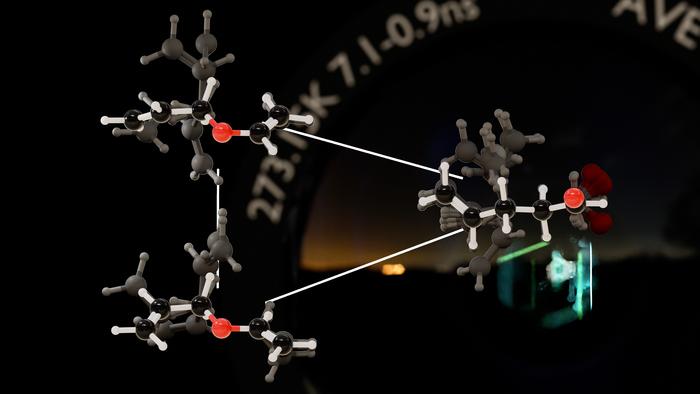Chemical reactions are commonly depicted as transitions from reactants to products. However, such reactions involve many molecules, and the individual molecules themselves undergo frequently-occurring structural changes as they transform from the reactants to the products. Even in the most straightforward chemical reactions, the actual observable changes that occur during the reaction are far quicker and far more complex than can be observed with any existing technology―similar to how fast-moving objects appear blurry in photos taken with a slow shutter speed.

Credit: Yumi Teruya
Chemical reactions are commonly depicted as transitions from reactants to products. However, such reactions involve many molecules, and the individual molecules themselves undergo frequently-occurring structural changes as they transform from the reactants to the products. Even in the most straightforward chemical reactions, the actual observable changes that occur during the reaction are far quicker and far more complex than can be observed with any existing technology―similar to how fast-moving objects appear blurry in photos taken with a slow shutter speed.
A research team in Japan, led by Professor Tamiki Komatsuzaki at the Institute for Chemical Reaction Design and Discovery (ICReDD), Hokkaido University, have developed a framework that accurately describes how first-order reactions appear depending on the time interval used to measure the reaction. Their work was described in the journal Proceedings of the National Academy of Sciences.
“During a reaction, the atoms of the reactants and products undergo a series of structural rearrangements, or isomerization, until the reaction is complete” Tamiki explains. “The speed at which these isomerizations occur means that we typically obtain only a simplified understanding of the process at any given point, through a process called coarse-graining.”
Yutaka Nagahata, first author of the study, elaborates, “We formulated a coarse-graining process that satisfies ‘exact lumping’ conditions—the exact matching of a simplified version of an equation with its original detailed counterpart, a theory proposed over half a century ago—by focusing on observation intervals, which can be thought of as the ‘shutter speed’ of a scientific observation. To adopt this matching, we formulated a criterion for the indistinguishability of the statistical behavior of stable molecular shapes (isomers) as a function of observation ‘shutter speed’.”
The team identified key observation intervals at which different molecular shapes “blur together” and the system appears to become simpler. They created a “systematic diagram” that shows how the reaction process appears more and more simplified as the observation interval increases, eventually appearing a one-step process (reactants directly changing into products) at long observation intervals. Using this “systematic diagram,” it is possible to immediately determine indistinguishable groups and obtain the rate equation over the groups by applying developed exact lumping.
“In developing exact coarse-graining, we have leapfrogged over current approximation theories, which possess many omissions that make them quite inaccurate,” says Professor Mikito Toda at the Graduate School of Information Science, University of Hyogo, and a coathour of the study.
The team used the Claisen rearrangement reaction of allyl vinyl ether to show that exact coarse-graining could account for all possible reaction paths. Future work will focus on extending this study to other first-order reactions. Ultimately, the researchers hope their work will provide a mathematical support of transition state theory.
===
World Premier International Research Center Initiative (WPI)
The WPI program was launched in 2007 by Japan’s Ministry of Education, Culture, Sports, Science and Technology (MEXT) to foster globally visible research centers boasting the highest standards and outstanding research environments. Numbering more than a dozen and operating at institutions throughout the country, these centers are given a high degree of autonomy, allowing them to engage in innovative modes of management and research. The program is administered by the Japan Society for the Promotion of Science (JSPS).
See the latest research news from the centers at the WPI News Portal: https://www.eurekalert.org/newsportal/WPI
Main WPI program site: www.jsps.go.jp/english/e-toplevel
Institute for Chemical Reaction Design and Discovery (ICReDD)
Hokkaido University
In-depth understanding and efficient development of chemical reactions:
ICReDD uses state-of-the-art reaction path search methods based on quantum chemical calculations and applies concepts of information science in order to extract meaningful information for experiments, thus narrowing down optimal experimental conditions. This approach enables “pinpointing” promising experiments.
https://www.icredd.hokudai.ac.jp
Journal
Proceedings of the National Academy of Sciences
DOI
10.1073/pnas.2317781121
Method of Research
Data/statistical analysis
Subject of Research
Not applicable
Article Title
An encompassed representation of timescale hierarchies in first-order reaction network
Article Publication Date
17-May-2024




